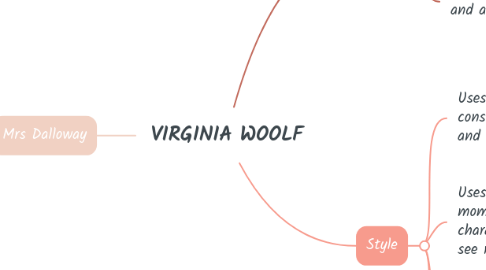
1. Mrs Dalloway
1.1. Setting
1.1.1. a day in June of 1923, from morning to evening, when she gives a party (climax)
1.1.2. Characters show humanity behind social masks
1.1.3. Tunneling technique: characters recollect their past during the story
1.2. A changing society
1.2.1. novel deals with the way people react to social changes
1.2.1.1. reflects the changes in the social life of the time
1.2.2. Time
1.2.2.1. striking of the Big Ben and clocks in general is a leitmotiv
1.2.2.1.1. reminds of the passing of time of life and of its flowing into death
1.3. Connection between Clarissa and Septimus
1.3.1. Clarissa
1.3.1.1. wife of a conservative MP. The influence of a possessive father and the frustration of a genuine love weakened her emotional self and split her in two
1.3.1.1.1. characterised by opposing feelings
1.3.1.2. In the end she recognises her deceptions, accepts the idea of death and is ready to go on
1.3.2. Septimus
1.3.2.1. suffers from PTSD/shell shock since his best friend Evans died during the war: he suffers from headaches and insomnia and is sexually impotent
1.3.2.2. In the end his psychic paralysis leads him to suicide
1.3.3. Both
1.3.3.1. their response to experience is given in physical terms
1.3.3.2. they depend on their partner
2. Life
2.1. Born in 1882, her father, Leslie Stephen, was a Victorian philosopher
2.1.1. Mother's death in 1895 led her to her first nervous breakdown
2.1.1.1. With her father's death in 1904 she began her literary life and career. She became a member of the Bloomsbury Group
2.1.1.1.1. In 1912 she married Leonard Woolf. She entered a nursing home and attempted suicide by taking drugs
2.2. Education: private Greek lessons and access to her father's library
2.2.1. She took part to the Bloomsbury Group, which included the avant-garde of the early 20th century London
2.2.1.1. In October 1929 she delivered two lectures at Cambridge: A Room of One's Own
2.2.1.1.1. impact on the feminist movement of the 60s and the 70s
3. Style
3.1. Uses the technique "stream of consciousness", maintaining logical and grammatical organisation
3.1.1. third-person, past tense narrative
3.1.1.1. POV shifted into the character's minds through flashbacks, associations of ideas and momentary impressions: continous flux
